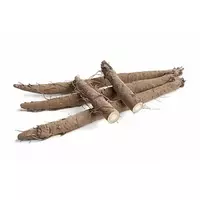Burdock root (burdock)

For several millennia, people continue to use as food a biennial plant (lat. Arctium), which is well known to the inhabitants of our latitudes, belonging to the Astrovy family. Burdock or burdock grows in temperate climatic zones on the European and Asian continents. Moreover, about six species of burdock grow in the Russian Federation, which are used not only for food, but also as a means of traditional medicine.
Benefits of burdock roots (burdock)
Moreover, both green leaves and shoots of the plant and the root of burdock (burdock) are used. The useful properties of burdock root (burdock) have been known to mankind for a long time. Nowadays, as a result of research, the useful properties of the burdock root (burdock) have received scientific confirmation. Scientists have found that the exceptional benefit of the roots of burdock (burdock) lies in the chemical composition of the plant. The thing is that both green leaves and shoots and in the rhizome of burdock contain a fairly large amount of natural compounds and vitamins and minerals useful for the human body.
Most often, for healing purposes, as well as as a food product, the roots of the great burdock or Arctium lappa, a plant that belongs to a species of perennial and is assigned to the Astrov family and the genus Lopukh, are used. It is noteworthy that the burdock is large or, as the people call this plant, the burdock is classified as ore, i. e. weed herbaceous plants. Burdocks grow near human dwellings, the easy availability of the plant played a decisive role and now the burdock is considered an effective folk way in the fight against some ailments and diseases.
The exceptional healing properties of burdock root (burdock) are contained in the chemical composition of the plant. For example, in the rhizome of burdock contains a colossal amount of natural amino acids (stearic, palmitic). In addition, the benefit of burdock root (burdock) lies in the content of inulin, sitosterol, protein, as well as tannins in the chemical composition of the plant. The roots of burdock (burdock) have found wider use in medicine than in cooking. However, burdock roots can and should even be eaten, since burdock is considered an excellent natural source of useful compounds indispensable for the human body.
Burdock root, like the rhizomes of other plants, can be used as a side dish or as a component of first courses, as well as salads. Usually, the root of burdock (burdock) is boiled, fried or stewed. In traditional medicine, burdock root is used to make tinctures and decoctions, which are usually used to treat food disorders, diabetes mellitus and other diseases of the human gastrointestinal tract. From the roots of burdock, turnip oil is made, which is considered one of the powerful and effective medicines.
burdock root (burdock) 72 kCal
Energy value of burdock root (burdock) (Ratio of proteins, fats, carbohydrates - ju):
Proteins: 1.53 g (~ 6 kCal)
Fats: 0.15g (~ 1 kCal)
Carbohydrates: 14.04 (~ 56 kCal)
Energy ratio (bj | y): 9% | 2% | 78%
 Español
Español Français
Français Português
Português Русский
Русский 简体中文
简体中文 繁體中文
繁體中文 日本語
日本語 한국어
한국어 العربية
العربية Türkçe
Türkçe Қазақ
Қазақ Deutsch
Deutsch Italiano
Italiano Українська
Українська
